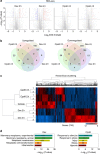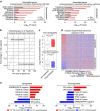Ligand-dependent genomic function of glucocorticoid receptor in triple-negative breast cancer
- PMID: 26374485
- PMCID: PMC4573460
- DOI: 10.1038/ncomms9323
Ligand-dependent genomic function of glucocorticoid receptor in triple-negative breast cancer
Abstract
Glucocorticoids (GCs) have been widely used as coadjuvants in the treatment of solid tumours, but GC treatment may be associated with poor pharmacotherapeutic response or prognosis. The genomic action of GC in these tumours is largely unknown. Here we find that dexamethasone (Dex, a synthetic GC)-regulated genes in triple-negative breast cancer (TNBC) cells are associated with drug resistance. Importantly, these GC-regulated genes are aberrantly expressed in TNBC patients and are associated with unfavourable clinical outcomes. Interestingly, in TNBC cells, Compound A (CpdA, a selective GR modulator) only regulates a small number of genes not involved in carcinogenesis and therapy resistance. Mechanistic studies using a ChIP-exo approach reveal that Dex- but not CpdA-liganded glucocorticoid receptor (GR) binds to a single glucocorticoid response element (GRE), which drives the expression of pro-tumorigenic genes. Our data suggest that development of safe coadjuvant therapy should consider the distinct genomic function between Dex- and CpdA-liganded GR.
Figures




Similar articles
-
Glucocorticoids and the non-steroidal selective glucocorticoid receptor modulator, compound A, differentially affect colon cancer-derived myofibroblasts.J Steroid Biochem Mol Biol. 2015 May;149:92-105. doi: 10.1016/j.jsbmb.2015.02.002. Epub 2015 Feb 7. J Steroid Biochem Mol Biol. 2015. PMID: 25666906
-
Compound A Inhibits Bladder Cancer Growth Predominantly via Glucocorticoid Receptor Transrepression.Mol Endocrinol. 2015 Oct;29(10):1486-97. doi: 10.1210/me.2015-1128. Epub 2015 Aug 31. Mol Endocrinol. 2015. PMID: 26322830 Free PMC article.
-
The rigid steroid 21-hydroxy-6,19-epoxyprogesterone (21OH-6,19OP) is a dissociated glucocorticoid receptor modulator potentially useful as a novel coadjuvant in breast cancer chemotherapy.Biochem Pharmacol. 2014 Jun 15;89(4):526-35. doi: 10.1016/j.bcp.2014.04.006. Epub 2014 Apr 13. Biochem Pharmacol. 2014. PMID: 24735610
-
The Role of Glucocorticoids in Breast Cancer Therapy.Curr Oncol. 2022 Dec 25;30(1):298-314. doi: 10.3390/curroncol30010024. Curr Oncol. 2022. PMID: 36661673 Free PMC article. Review.
-
Glucocorticoid receptors orchestrate a convergence of host and cellular stress signals in triple negative breast cancer.J Steroid Biochem Mol Biol. 2024 Oct;243:106575. doi: 10.1016/j.jsbmb.2024.106575. Epub 2024 Jun 29. J Steroid Biochem Mol Biol. 2024. PMID: 38950871 Review.
Cited by
-
Dexamethasone enhances the antitumor efficacy of Gemcitabine by glucocorticoid receptor signaling.Cancer Biol Ther. 2020 Apr 2;21(4):332-343. doi: 10.1080/15384047.2019.1702399. Epub 2020 Jan 7. Cancer Biol Ther. 2020. PMID: 31906826 Free PMC article.
-
Mechanisms behind context-dependent role of glucocorticoids in breast cancer progression.Cancer Metastasis Rev. 2022 Dec;41(4):803-832. doi: 10.1007/s10555-022-10047-1. Epub 2022 Jun 27. Cancer Metastasis Rev. 2022. PMID: 35761157 Free PMC article. Review.
-
Nuclear Receptor Function through Genomics: Lessons from the Glucocorticoid Receptor.Trends Endocrinol Metab. 2017 Jul;28(7):531-540. doi: 10.1016/j.tem.2017.04.001. Epub 2017 May 8. Trends Endocrinol Metab. 2017. PMID: 28495406 Free PMC article. Review.
-
Glucocorticoid Receptor: A Multifaceted Actor in Breast Cancer.Int J Mol Sci. 2021 Apr 24;22(9):4446. doi: 10.3390/ijms22094446. Int J Mol Sci. 2021. PMID: 33923160 Free PMC article. Review.
-
Nuclear Receptor Imaging In Vivo-Clinical and Research Advances.J Endocr Soc. 2022 Dec 31;7(3):bvac197. doi: 10.1210/jendso/bvac197. eCollection 2023 Jan 6. J Endocr Soc. 2022. PMID: 36655003 Free PMC article. Review.
References
-
- Schmidt S. et al.. Glucocorticoid-induced apoptosis and glucocorticoid resistance: molecular mechanisms and clinical relevance. Cell Death and Differ. 11, (Suppl 1): S45–S55 (2004). - PubMed
-
- Rutz H. P. Effects of corticosteroid use on treatment of solid tumours. Lancet 360, 1969–1970 (2002). - PubMed
-
- Zhang C. et al.. Clinical and mechanistic aspects of glucocorticoid-induced chemotherapy resistance in the majority of solid tumors. Cancer Biol. Ther. 6, 278–287 (2007). - PubMed
Publication types
MeSH terms
Substances
Associated data
- Actions
Grants and funding
LinkOut - more resources
Full Text Sources
Other Literature Sources
Medical
Molecular Biology Databases
Miscellaneous

